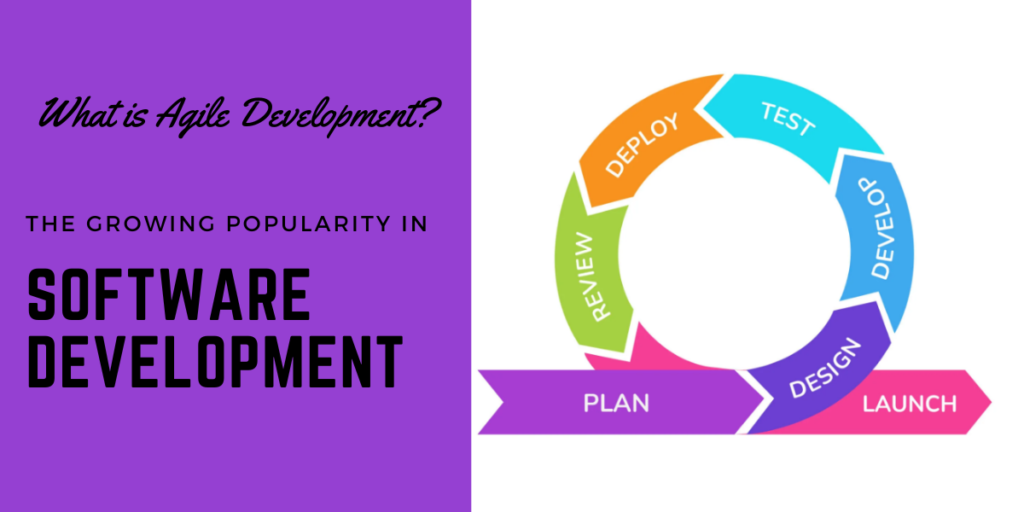The agile paradigm of software development is gaining ground on the V-shaped model. This paradigm is built on iterations and feedback, and it enables rapid and effective modifications. The V-shaped model is a hybrid of the two most prevalent models in use today: Agile and Waterfall. Below are some statistics given for a better approach.
According to Facts and Factors, by 2026, the global demand for Agile Development and Testing Services would reach $ 30 billion.
What is Agile Development

Before Agile, the Waterfall methodology was the gold standard for Software Development. Developing any software product required a ton of documentation before coding even began. Business analysts prepared the requirements documentation, technical department then prepared their technical requirement documentation from it. Then coding and testing come to the floor.
Agile Product Development is a more efficient method of developing any software. It is an approach that focuses on people and results. Using technologies like Scrum and Extreme Programming, it is simple and flexible to increase quality. Unlike the waterfall approach of “plan, design, build, test, and deliver,” the Agile methodology operates on a quick and incremental basis.
Why is Agile so Popular
Agile methodology overcomes the risk of spending a lot of time if there are any changes required. It allows teams to work directly with clients, instead of working with other teams. This provides a clear outcome with a focused goal and in an incremental way.
From a variety of viewpoints, organizations considered Agile to be more beneficial than the waterfall process. Agile is prevalent in the manufacturing, FMCG, and car industries, in addition to the IT business.
Benefits of Agile Methodology
- Agile is Faster and Smaller
Other software development methods focus on the pre-designed process of knowing the requirements of customers, planning the development, designing the software, building the product, testing, and result delivery. This might take several months or even years. However, Agile emphasizes releasing the initial progress in a few weeks or the full piece of software in a few months. - Customer and Result Oriented
They will deliver excellent products to clients on schedule if Agile best practices are implemented throughout the organization. Agile’s popularity stems mostly from satisfied consumers. Customers are involved throughout the whole Agile process so that they may receive updates on their goods and ensure that they match their criteria. - Multiple Agile Methodologies can be Used
Scrum, Kanban, extreme Programming (XP), Dynamic Systems Development Method (DSDM), Feature Driven Development (FDD), Adaptive Software Development (ASD), Lean Software Development (LSD), and Crystal are the methods of Agile software development. The most popular Agile practices used are Scrum and extreme Programming (XP). - Agile Enhances Productivity
Agile is aimed to enhance productivity and therefore, it creates a specific culture to be focused on productivity. The open-source nature of Agile has made it simple for teams to grasp the purpose of each iteration. - A Critical Method in Agile: INVEST
Another crucial factor in Agile’s productivity is INVEST. It’s an acronym for a checklist. Let’s elaborate on this. Autonomous, Negotiable, Profitable, Enviable, Verifiable, and Small Stories. - Agile is Reliable.
Agile teams self-organize and chart their own course rather than adhering to a set of rules. They are focused on achieving their objectives.
Agile Vs. Waterfall Methodology
Agile
- Agile takes a step-by-step methodology.
- Agile is well-known for its adaptability. As a result, adjustments can be made after the original planning is accomplished.
- Testing is done concurrently with development in agile.
- Prefers a concentrated work environment with a high level of cooperation and synchronization.
- The Agile methodology expects requirements to change and adapt.
Waterfall
- The Waterfall design method is a sequential design approach.
- Once the development process begins, no alterations are permitted.
- Only during the testing phase should testing be performed.
- Waterfall does not prioritize team collaboration and synchronization.
- The waterfall operates with certain specifications and no modifications are planned.
Top Agile Tools
- JIRA
Jira is a customizable project management tool. It is widely used and may be tailored to meet specific needs. It includes a customizable Scrum Board that can be used to evaluate all the tasks in the sprint, as well as a burnout chart, sprint report, velocity chart, epic report, cumulative flow diagram, and so on. It includes JQL-based custom filters (Jira Query Language). Furthermore, adaptable Kanban boards produce the most output with the least amount of effort. - Active Collab
This is a robust management tool that aids in everything from job juggling to time monitoring and bill generation. It includes a system-wide calendar that aids in understanding the duties allocated to each team member. Active collab is a robust documentation system that includes a collaborative authoring tool that allows any member to contribute to the documentation. - Asana
Asana excels in focusing on a few key aspects. Work is simple to visualize with Asana. On the board, it is simple to choose between six distinct views: timeline, list, calendar, progress tracker, and forms. With a drag-and-drop board, it is easy to organize the work. Create a project board and begin adding sections and subtasks to create task order. Asana’s templates will assist agile teams with activities such as bug tracking, sprint planning, establishing agendas for standups and retrospectives, and roadmap planning.
Conclusion
The agile technique provides advantages; according to the research, Agile delivery works best. Agile ensures higher success rates, while the methodology’s flexibility less customized software. Allowing stakeholders to make informed decisions at key moments reduces numerous risks, and better decisions lead to better delivery.
XDuce adapted Agile methodology many years before. We worked for the betterment of our clients. A V-shaped model is a good option for companies, combining the quick turnaround times of Agile with the detailed planning and documentation of Waterfall.